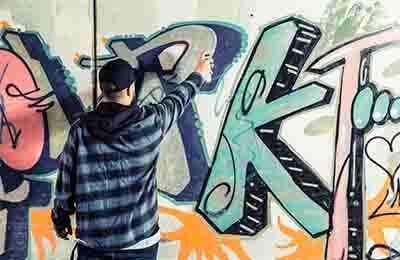美国总统的涂鸦
时间:2022-06-19 06:28:40

We usually imagine White House meetings to be efficient and focused on grave matters; we don’t imagine the president dithering, daydreaming, or making idle scribbles—especially during moments of national crisis. But presidents, like the rest of us, doodle.
In an age of politics as scripted spectacle, these doodles, made without speechwriters, promise a glimpse of the unguarded president. Because their meaning may be opaque even to the doodler himself, they invite us to interpret them as we wish.
我们总是以为白宫的会议是富有效率的,讨论的都是重大问题。我们不会想到,美国总统会犹豫不决、陷入幻想,或者在纸上胡写乱画,特别是在需要应对国家危机之际。其实,总统们也会像我们一样信手涂鸦。
在政治家照本宣科蔚为大观的时代,这些涂鸦不经演讲撰稿人捉刀,让我们得以一睹毫无防备的总统的内心世界。因为这些涂鸦所包含的意思,甚至连总统本人都解释不清,所以如我们所愿,这些涂鸦需要我们好好解读一番。
Herbert Hoover
(1929~1933)
Trained as an engineer, Hoover was one of the most prolific presidential doodlers. His pictures are consistently geometric, intricate, and clever in the way they link disparate parts into a larger whole. But while his doodles hinted at elaborate and expansive visions, they never included any people. This failure to take human beings into account was all too evident in his slow reaction to the Great Depression.
赫伯特·胡佛总统(1929~1933年在任)
因为工程师出身,胡佛总统是涂鸦作品最多的美国总统之一。他的图画始终呈几何形状、复杂多变,并且构图巧妙,迥然不同的各部分可以浑然一体。但是,当他的涂鸦作品透露出复杂的、天马行空的想象力时,从未有人物肖像出现在其中。从胡佛总统对20世纪30年代经济大萧条的优柔寡断,很明显看得出他忽视人的因素。
Dwight D. Eisenhower (1953~1961)
More than any other president, Eisenhower doodled on agendas, memos, and other official documents. This agenda, from June 28, 1954, didn’t list the crisis in Guatemala as an item for discussion, but Eisenhower did. The day before, CIA-backed forces had deposed the government of Jacobo Arbenz in favor of a regime that was more pro-American. With Guatemala clearly on his mind, the president sketched himself as a trim young man with big gunboats backing him up.
德怀特·艾森豪威尔总统(1953~1961年在任)
比起其他任何总统,艾森豪威尔总统更喜欢在议程表、备忘录和其他公文上涂鸦。从1954年6月28日开始,白宫没有将发生在危地马拉的危机列到议程表上作为讨论事项,但是艾森豪威尔总统记了下来。在此前一天,美国中央情报局支持的武装部队已经废黜了雅科布·阿本兹政府,支持建立了一个更加亲美的政权。艾森豪威尔总统对危地马拉的事态胸有成竹,他用素描把自己画成一个身材修长的年轻人,背后有大型炮舰停靠。
John F. Kennedy (1961~1963)
Kennedy’s doodles are heavily textual—reflecting his verbal, cerebral nature. He often repeats a word or phrase and sets each one in its own box. In some doodles, Kennedy writes one or two or three words over and over, in a tense, almost obsessive repetition, as if he were trying to work through whatever anxiety was confronting him. Although one should attempt presidential mind reading with the utmost caution, it seems safe to say that in this doodle JFK was concerned about Vietnam.
约翰·肯尼迪总统(1961~1963年在任)
肯尼迪总统的涂鸦有大量的文字,反映出他天生就善于言词、富有理性。他经常重复写一个单词或者短语,并画上方框圈起来。在一些涂鸦中,肯尼迪总统一刻也不停歇地、几乎痴迷地重复写一个、两个或者三个单词,好像在竭力应付所有无法回避的焦虑。虽然人们应该小心翼翼地努力揣摩总统的心思,但是可以肯定的是,肯尼迪总统在这幅涂鸦中表示了对越南战局的忧虑。
Ronald Reagan
(1981~1989)
Like his folksy stories, Reagan’s kitschy doodles—most of them cartoon renderings of himself as a bandana-wearing cowboy, a running back, or a rugged leading man—trigger warm associations with an idyllic American past.
罗纳德·里根总统(1981~1989年在任)
像他亲民的故事一样,里根总统那些毫无艺术价值的涂鸦,大多数是用卡通画的形式把他自己画成一个戴着色彩艳丽的头巾的牛仔、一个球场上的后卫或者一个长相粗犷的男主角,触发了我们对诗情画意的美国往昔岁月的美好联想。
Lyndon B. Johnson (1963~1969)
Johnson’s White House may well have been the most dedicated to doodle collecting. After each meeting, an aide would round up whatever notes were left, even if they had been crumpled or ripped up. The president shows his predilection for drawing figures with three faces. The drawing also reveals his habit of building his doodles around the words The White House on his stationery. At various times Johnson turned his residence into a flag, a pagoda, and a prison.
林顿·约翰逊总统(1963~1969年在任)
约翰逊的白宫生涯很可能是为总统涂鸦集萃贡献最多的。每次会议后,一名助手会集拢任何留下来的便条,即使它们已经被弄皱或者撕成碎片。约翰逊总统偏爱画长着三张脸的人像。从他的画中也可看出他的一个习惯,就是喜欢在信纸上印有“白宫”字样抬头的周围涂鸦。很多次,他把白宫画成一面旗帜、一座宝塔和一座监狱。
George H. W. Bush (1989~1993)
The one significant drawing—a sad, tearful face—currently available in Bush’s presidential papers appears on a memo he wrote to Rose Zamaria, his secretary. According to Zamaria, the president was responding to her request that he sign a stack of letters addressed to people he knew. Looking over the names, Bush realized that one intended recipient was dead and another might be. Zamaria explained, “You see, he was such a funny guy.”
乔治·老布什总统(1989~1993年在任)
这幅目前可在老布什总统的文件中看到的意味深长的画——一张悲伤流泪的脸——出现在他写给自己的秘书罗斯·萨马里亚的一份备忘录上。据萨马里亚回忆,老布什总统当时正应她的要求,在一大叠写给他认识的人的信件上签名。老布什总统在查看这些收件人姓名时,意识到其中一位早已过世,而另一位也可能如此。萨马里亚解释道:“你瞧,他就是这么一个有趣的家伙。”
